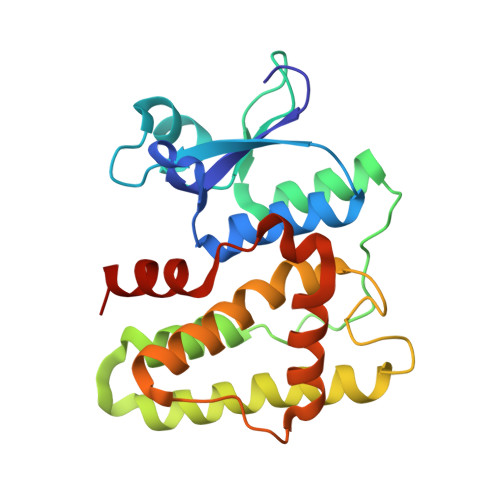Enzymatic characterization and crystal structure analysis of Chlamydomonas reinhardtii dehydroascorbate reductase and their implications for oxidative stress
Chang, H.Y., Lin, S.T., Ko, T.P., Wu, S.M., Lin, T.H., Chang, Y.C., Huang, K.F., Lee, T.M.(2017) Plant Physiol Biochem 120: 144-155
- PubMed: 29028546
- DOI: https://doi.org/10.1016/j.plaphy.2017.09.026
- Primary Citation of Related Structures:
5XFT - PubMed Abstract:
Dehydroascorbate reductase (DHAR) is a key enzyme for glutathione (GSH)-dependent reduction of dehydroascorbate (DHA) to recycled ascorbate (AsA) in plants, and plays a major role against the toxicity of reactive oxygen species (ROS). Previously, we proposed that the increase of AsA regeneration via enhanced DHAR activity modulates the ascorbate-glutathione cycle activity against photooxidative stress in Chlamydomonas reinhardtii. In the present work, we use site-directed mutagenesis and crystal structure analysis to elucidate the molecular basis of how C. reinhardtii DHAR (CrDHAR1) is involved in the detoxification mechanisms. Mutagenesis data show that the D21A, D21N and C22A mutations result in severe loss of the enzyme's function, suggesting crucial roles of Asp-21 and Cys-22 in substrate binding and catalysis. The mutant K11A also exhibits reduced redox activity (∼50%). The crystal structure of apo CrDHAR1 further provides insights into the proposed mechanism centering on the strictly conserved Cys-22, which is suggested to initiate the redox reactions of DHA and GSH. Furthermore, in vitro oxidation of the recombinant CrDHAR1 in the presence of 1 mM H 2 O 2 has minor effects on the K m for the substrates but significantly reduces the k cat . The enzyme's activity and its mRNA abundance in the C. reinhardtii cells are increased by treatment with 0.2-1 mM H 2 O 2 but decreased when H 2 O 2 is ≥ 1.5 mM. The latter decrease is accompanied by oxidative damage and lower AsA concentrations. These biochemical and physiological data provide new insights into the catalytic mechanism of CrDHAR1, which protects the C. reinhardtii cells from oxidative stress-induced toxicity.
Organizational Affiliation:
Department of Marine Biotechnology and Resources, National Sun Yat-sen University, Kaohsiung 80424, Taiwan; The Asia-Pacific Ocean Research Center, National Sun Yat-sen University, Kaohsiung 80424, Taiwan; Doctoral Degree Program in Marine Biotechnology, National Sun Yat-sen University, Kaohsiung 80424, Taiwan. Electronic address: hychang@mail.nsysu.edu.tw.














